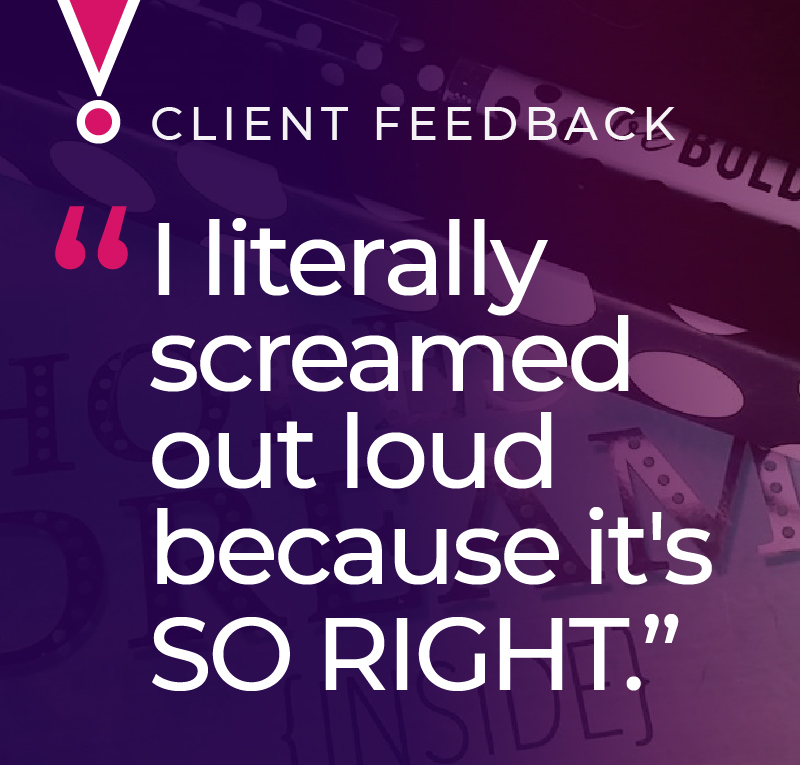
In case you're not familiar with them, a mood board is "an arrangement of images, materials, pieces of text, etc. intended to evoke or project a particular style or concept." Basically, it's a collage that explores ways to evoke the feeling (or mood) you're after in a design
I introduced mood boards into my design process just a few years ago, and now I hate to imagine skipping that step. I have to admit though, there's still a part of me that worries clients who aren't familiar with the concept will think it's a waste of time. Can't we just get to the design part already?
There's no point in going down the wrong road. If you're not clear on some aspect of what you're trying to communicate, that mood board won't feel like a "hell yes", and you'll see where you have some work to do.

If you ARE clear on where you're going but the mood board doesn't express it, revamping it will help your designer get on the same page.
Once the mood board feels right, everything afterward flows into place much more smoothly. The beginnings of your color palette, fonts, shapes, colors, and image choices are all right there, ready to be developed into a final design that really gets your point across.
Images are a powerful form of expression. They get in under the skin, before the words do. If you're working on a book right now, a mood board can help you stay focused on the overall purpose you're trying to convey. And as a bonus, it can help guide your cover design when you're done.
Here's the great thing about a mood board: it's one way to bypass thinky-brain and get at what's underneath.
One reader who went through my 5-day Brand Clarity Workshop (which leld through the DIY process of making a mood board) said this:
"When you had me do a mood board, I was resistant. I could not see how it would help. But once I allowed myself to go with it, so much became clear. It allowed me to focus."
Exactly.
I get that it can seem kind of stupid and pointless. Thinky-brain wants to just come up with all the answers. Thinky-brain wants it to be about logic
Thinky-brain doesn't want to let it be play. If it's fun, it can't be worthwhile, right? We must logic our way to the truth, with rightness and words.
Here's the problem with that: thinky-brain likes things it already knows. Things it's heard before. And thinky-brain is as susceptible to bias and manipulation as anything, even though it's so sure it's logical and correct.
I'm not saying throw out thought, or words, or logic. But it's useful to bypass them for awhile, to see what truths you can uncover beneath the level of conscious thought. A mood board can help you do that. It definitely helps me.
Check out this mood board I designed for a client:
What do you see? How do you think this person shows up? What's important to her, and what it's like to work with her
This client works in the insurance industry, and her customers are older people beginning to navigate the Medicare system. There's a lot to know, and it can be really stressful and confusing. It's really important to my client to make personal connections with her customers, and to keep the whole process feeling warm, safe, and easy. Her customers can feel how genuinely she cares, which is why almost all of her business comes in by referral. She loves them, they love her, it's a big old love fest.
So many insurance agents are out there with cold, stiff, clunky brands, or just a cluttered mess, totally focused on the products they're offering. But their competitors have access to pretty much the same products. The SERVICE my client offers is knowing and loving her customers so well that she can help them find the best path for their situation, whatever that is, and they come out of it knowing a lot more than they did before, because they've had a friend guiding them through. And she'll probably bake them cookies or bring over a pot of soup.
That kind of warmth and cheer needed happy colors, casual poses, sunshine, and smiles. And dogs. The one less vibrant image on the board is of a dog being cradled, hugged, warm, safe. The selfie of Reese Witherspoon and her mom - not for use in any actual brand materials, obviously - really captures the feel. So caring, so warm.
I swap a lot of images in and out when I do these boards. It can take time and experimentation to get the balance and the feel just right. It's worth it. You uncover so much depth, and form such a strong foundation for the work going forward.
It’s not just a collage - it’s a visual first-step in bringing together a cohesive brand, in terms of both look and feel. Once you know you’re on the right track, things like book covers, logos, and websites come together more quickly (and easier, too!)
